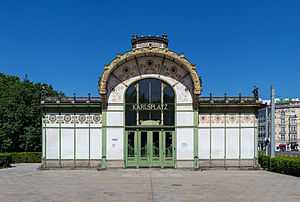Otto Wagner
| Otto Wagner | |
|---|---|
 | |
| Born |
Otto Koloman Wagner 13 July 1841 Vienna, Austrian Empire |
| Died |
11 April 1918 (aged 76) Vienna, Austria-Hungary |
| Nationality | Austria-Hungarian |
| Occupation | Architect |
| Buildings |
Floodgate, Nußdorf, Vienna Rumbach Synagogue |
| Projects | Viennese Wiener Stadtbahn |
Otto Koloman Wagner (German: [ˈɔto ˈvaːɡnɐ]; 13 July 1841 – 11 April 1918) was an Austrian architect and urban planner, known for his lasting impact on the appearance of his home town Vienna, to which he contributed many landmarks.
Life and career
Wagner was born in Penzing, a district in Vienna. He was the son of Suzanne (née von Helffenstorffer-Hueber) and Rudolf Simeon Wagner, a notary to the Royal Hungarian Court.[1][2][3] He studied in Berlin and Vienna. In 1864, he started designing his first buildings in the historicist style. In the mid- and late-1880s, like many of his contemporaries in Germany (such as Constantin Lipsius, Richard Streiter and Georg Heuser), Switzerland (Hans Auer and Alfred Friedrich Bluntschli) and France (Paul Sédille), Wagner became a proponent of Architectural Realism. It was a theoretical position that enabled him to mitigate the reliance on historical forms. In 1894, when he became Professor of Architecture at the Academy of Fine Arts Vienna, he was well advanced on his path toward a more radical opposition to the prevailing currents of historicist architecture.
By the mid-1890s, he had already designed several Jugendstil buildings. Wagner was very interested in urban planning — in 1890 he designed a new city plan for Vienna, but only his urban rail network, the Stadtbahn, was built. In 1896 he published a textbook entitled Modern Architecture in which he expressed his ideas about the role of the architect; it was based on the text of his 1894 inaugural lecture to the Academy. His style incorporated the use of new materials and new forms to reflect the fact that society itself was changing. In his textbook, he stated that "new human tasks and views called for a change or reconstitution of existing forms". In pursuit of this ideal, he designed and built structures that reflected their intended function, such as the austere Neustiftgasse apartment block in Vienna.
In 1897, he joined Gustav Klimt, Joseph Maria Olbrich, Josef Hoffmann and Koloman Moser shortly after they founded the "Vienna Secession" artistic group. From the ideas of this group he developed a style that included quasi-symbolic references to the new forms of modernity.
Wagner died in Vienna in 1918.
Major works
- Austria
- Nussdorf weir and lock, Vienna (1894)
- Viennese Wiener Stadtbahn, metropolitan railway system, e.g. Karlsplatz Stadtbahn Station
- Majolica House (Majolikahaus), Vienna (1898–1899)
- Postal Office Savings Bank Building, Vienna (1894–1902)
- Kirche am Steinhof, Vienna (1903–1907)
- Hungary
- Rumbach Street synagogue, Budapest (1872)

Publications
- Wagner, Otto (1988). Modern Architecture: A Guidebook for His Students to This Field of Art. Trans. Harry F. Mallgrave. Santa Monica: Getty Center for the History of Art and the Humanities. ISBN 0-226-86938-5.
References
- ↑ Slesin, Suzanne; Cliff, Stafford; Rozensztroch, Daniel (25 October 1994). Mittel Europa: rediscovering the style and design of Central Europe. C. Potter. Retrieved 16 July 2012.
- ↑ Wagner, Otto (1987). Graf, Otto Antonia, ed. Masterdrawings of Otto Wagner: an exhibition of the Otto Wagner-Archiv, Academy of Fine Arts, Vienna. The Drawing Center. Retrieved 16 July 2012.
- ↑ "Otto Koloman Wagner - Vienna 1900". depts.washington.edu. 2003. Retrieved 16 July 2012.
Further reading
- Mallgrave (ed.), Harry (1993). Otto Wagner: Reflections on the Raiment of Modernity. Santa Monica: Getty Center for the History of Art and the Humanities. ISBN 0-89236-257-X.
- Duncan Berry, J. (1993). "From Historicism to Architectural Realism: On Some of Wagner’s Sources". In Harry Mallgrave. Otto Wagner: Reflections on the Raiment of Modernity. Santa Monica: Getty Center for the History of Art and the Humanities. pp. 242–278. ISBN 0-89236-257-X.
- Graf, Otto Antonia (1994). Otto Wagner: Das Werk des Architekten 1860-1918 (in German). Vienna: Bölhau. ISBN 3-205-98224-X.
- Kolb, Günter (1989). Otto Wagner Und Die Wiener Stadtbahn (in German). Munich: Scaneg. ISBN 3-89235-029-9.
- Schorske, Carl (1981). "The Ringstrasse and the Birth of Urban Modernism". Fin-De-Siècle Vienna: Politics and Culture. New York: Vintage Books. ISBN 0-394-74478-0.
- Muller, Ines (1992). Die Otto Wagner-Synagoge in Budapest (in German). Wien: Löcker. ISBN 978-3-85409-200-1.
- Geretsegger, Heinz (1979). Otto Wagner, 1841-1989; the Expanding City; The Beginning of Modern Architecture. New York: Rizzoli. ISBN 0-8478-0217-5.
External links
| Wikimedia Commons has media related to Otto Wagner. |
- Otto Wagner Museum in Vienna
- Great Buildings Online
- Images of several Wagner buildings
- Otto Wagner at WOKA (de/en)
- Majolica House in Vienna by Otto Wagner (with drawings and photos)
- AEIOU - Das österreichische Kulturinformationssystem
Digitized books from the architecture collection of AMS Historica, the digital library of the University of Bologna.
- (German) Einige skizzen 1, Wien, 1905.
- (German) Einige skizzen 2, Wien, 1905.
- (German) Einige skizzen 3, Wien, 1905.
|
